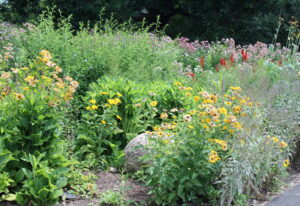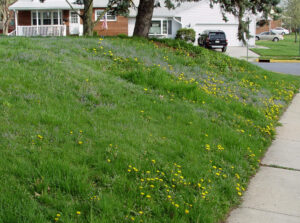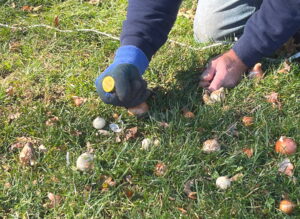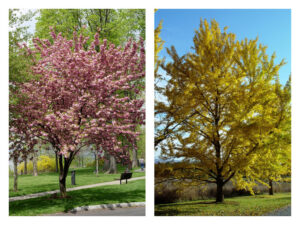Gardening Trends of 2023
January 3rd, 2023
The early 2000s were more about self-indulgence, but heading into 2023, gardeners are making a turn toward self-reliance.

A desire for privacy in the yard is a hot trend heading into 2023.
That’s the view from Katie Dubow, president of the Chester County-based Garden Media Group, a garden-centric public-relations company that each year produces a Garden Trends Report.
“We’re fighting to establish ourselves in a crazy, mixed-up world,” says Dubow. “We’re educating ourselves on how to create a life that represents us, meets our needs, and reduces our dependency on people and systems… We got through COVID and grew our own food. What can’t we do?”
She and other trend-watchers see a variety of ways this outlook will take shape on the gardening front in 2023.
“Living walls”
Maybe we got used to cocooning during the COVID pandemic… or maybe it’s a desire to create a haven from that crazy outside world.
Either way, people more than ever are looking for privacy in the yard, says Chris Uhland, a board member of the Pennsylvania Landscape and Nursery Association and president of Harmony Hill Nursery in Downingtown, Pa.
“With more people living in small spaces, we see them getting creative with natural screening,” he says. “Living walls, as we call them, help create privacy, block noise, and help create rooms outside.”
This approach goes beyond stark fences and rows of conventional arborvitae into a mix of specimen upright conifers, flowering shrubs, blooming small trees, and vine-covered arbors, trellises, and walls.
Read George’s PennLive post on eight ways to add more privacy to the yard
Gardening as therapy
An estimated 18 million Americans took up gardening during the COVID pandemic as a way to get outside, do something healthy, eat better, and/or simply improve their mindset.
Diane Blazek, executive director of the National Garden Bureau, thinks those reasons will continue to fuel interest in gardening even as COVID fades.
Her take: “As more people realize the health and well-being benefits that gardening provides, they will spread the word, and even more people will garden for the same reasons.”
Blazek points out that life stresses in general cause people to seek a “safe, calming outlet, and that is the garden… be it your own balcony or back yard, or a community garden, or even your local public garden.”
And she adds that medical professionals are increasingly encouraging gardening as a form of therapy.
The “Tesla effect”
Gardeners seem to be taking a more active role in how they’re affecting the environment around them, says Dubow.
One specific trend she cites is the move toward electronic and battery-powered yard tools as opposed to noisier and more air-polluting gas-powered ones.
She points to surveys from the Freedonia Group market-research firm showing that electric or battery-powered mowers, leaf blowers, and other lawn and garden equipment now account for 17 percent of the market – three times that of electric cars.
“Arizona offers vouchers to switch to electric lawn equipment, and California will ban gas-powered mowers by 2024,” Dubow says. “Yet people are switching without the added push.”

Native plants remain trendy.
Native plants
The most glaring example of enviro-friendly gardening has been the shift in the last decade toward native plants, primarily because of their benefits to pollinators and other native wildlife.
Pennsylvania Landscape and Nursery Association board member Larry Sheehan says demand for native plants continues to grow, especially ones native to Pennsylvania.
“Gardeners show a rising interest in learning about Pennsylvania native plants, why they are important, and the value of using them in their own landscapes,” says Sheehan, who’s a consultant for Virginia-based Ingleside Plantation Nurseries.
Read George’s PennLive post on top native plants for multi-season interest
Bee lawns
A new offshoot of the help-the-pollinators movement is the “bee lawn.”

This isn’t a weedy lawn… it’s a “bee lawn.”
This budding idea involves mowing the lawn less often, allowing pollinator-attracting flowering plants (i.e. “weeds”) to grow along with the turfgrass, and even purposely planting seeds of plants other than grass.
Penn State’s Center for Pollinator Research says many plants widely considered to be lawn weeds are actually valuable to bees, such as dandelions, birdsfoot trefoil, and especially clover.
The state of Minnesota is so sold on the idea that it’s been adding bee lawns to state parks and offering residents up to $350 each to plant home bee lawns.
Research by the University of Minnesota’s Turfgrass Science Lab and Bee Lab found that besides helping pollinators, bee lawns require less maintenance, water, and fertilizer than traditional lawns; they perform better in poor sites: they save time, money, and fossil fuels from less mowing (every two weeks is recommended), and they add diversity and a “pleasing visual component” to the landscape from the colorful foliage and flowers.
Bulbs in the lawn
Related to the above is giving pollinators an early-season pollen source by planting short, early-blooming flower bulbs directly into the lawn.

Short bulbs can be planted directly into lawns for early-spring color.
Flowerbulbs.com, an arm of the Dutch bulb industry, says “bulb lawns” have been occasionally displayed in public gardens but are now starting to catch on in home gardens.
Shorties like crocuses, snowdrops, Siberian squill, and glory-of-the-snow pop up through the turf in early spring, then go dormant and die back by the time grass hits peak-growth form. (Mowing should be delayed until the bulb foliage begins to yellow.)
One bulb supplier, Colorblends, says visitors were so enamored by the display bulb lawn at its display garden in Connecticut last spring that it started offering lawn-geared mixes called “Color Your Grass” this past fall.
Even more houseplants
Houseplants have been hot sellers the past few years, and the Pennsylvania Horticultural Society’s vice president of horticulture Andrew Bunting sees it continuing as one of gardening’s top trends again in 2023.
The latest niche, he says, is aroids – plants in the arum family.
He points to the U.S. Botanic Garden’s popular aroid exhibit at the 2022 Philadelphia Flower Show as well as people’s fascination with the species’ oddest member – the titan arum, which sends up huge bloom spikes that smell like rotting flesh.
Bunting says some of the big-leaf members of the houseplant clan are spilling over into outdoor use, too.
“Many of the elephant ears continue to grow in popularity, and some like ‘Pharaoh’s Mask’ have sold for hundreds of dollars,” he says. “Caladiums that were once popular in Victorian times have seen an amazing renaissance with new introductions like ‘White Christmas’ and ‘Crimson Sky.’”
A third trend in houseplants is a move towards more colorful choices, says Ball Horticultural Co. spokesperson Katie Rotella.
“’Plant parents’ are starting to bring potted flowering plants into their ‘jungalos,’” she says. “Look for the expansion of tastes toward indoor flowers instead of just leafy foliage houseplants.”
Home-grown fruits
One other hot trend that’s continuing is growing our own edibles.
Fueled by COVID, vegetable gardens have made a comeback the last three years, especially among younger gardeners.
Brandon Kuykendall, the nursery manager at Ashcombe Farm and Greenhouses in Monroe Twp., says “knowing where your food is coming from” has been a key reason behind the grow-your-own trend.
He says the latest twist is home-grown bush fruits.
“There was an uptick in hardy fruiting perennials this year,” he says. “Our numbers were up for blueberries, strawberries, and brambles.”
Plants that don’t need trimming
“It seems people are not wanting all of the maintenance of trimming back their old overgrown shrubbery anymore, which of course starts to look awful from repeated hacking,” says Adams County landscape designer Erica Shaffer. “Close to 50 percent of my design work this year was total tear-outs and replacement landscaping.”
Shaffer says that most of her clients are replacing their older hulks with low-care, compact, and slow-growing shrub and evergreen selections.
Rotella says that Ball is seeing a similar trend in annual flowers – a preference for varieties that need less water and don’t need any deadheading or spraying.
“The trick is to strategically select eye-catching flowers that have built-in durability,” Rotella says, mentioning such species as begonias, salvias, angelonia, and vinca. “There are many plants that offer beautiful blooms with surprisingly little work.”

Crabapple and ginkgo are two species that can take our coming heat.
Heat-tough trees
Now that more than half of the country (including the Harrisburg area) is a half of a growing zone warmer than just a decade ago, it’s time to rethink our tree selection, says Dr. Dan Herms, an arborist with Davey Tree.
Herms says the climate is warming fast enough to change the hardiness zone within the lifespan of trees planted today, meaning we should lean toward species that can take the coming heat (oaks, red maple, crabapple, sweetbay magnolia, and American hornbeam, for example) and away from familiar species that are vulnerable to high heat (i.e. sugar maple, birch, beech, eastern white pine, and spruce).
Read George’s PennLive post on trees that can take our future heat
Greek-style gardens
One last developing trend that Dubow mentions is an uptick in gardens influenced by ancient Greece.
This look features statuary, stone walls and archways, terra cotta pots, vines, and symmetrical plantings.
“Key plants are hardy, water-wise succulents, boxwoods, and roses,” she says.
She adds that gravel gardens – a staple of Greek design and its Mediterranean environment – also are trending.
Read George’s PennLive column on how to build a crevice garden, a form of gravel or rock gardening
“These look amazing in heat and drought and require 80 percent less maintenance,” Dubow says. “Plus, they offer incredible environmental benefits, thriving on rainfall alone with no fertilizer or other additives needed. They’re great for small spaces, or they can encompass an entire front yard.”







